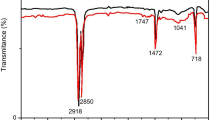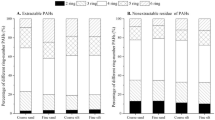Abstract
Amphiphilic polyurethane (APU) nano-particle enhanced the mobilization of 2-methylnaphthalene (2-MNPT) in soil. Significant increase in the solubility of 2-MNPT was achieved. The molar solubilization ratio was 0.4 (mole 2-MNPT/mole APU). Simple precipitation of APU particle by 2 N CaCl2 recovered 95% of APU particle and 92% of 2-MNPT simultaneously. Also, 2-MNPT, which was entrapped inside the APU particle, was directly degraded by Acinetobacter sp. as same efficiency as without APU particle. These results showed the potentials of APU particle in the mobilization and biodegradation of hydrophobic compounds from soil.








Similar content being viewed by others

References
Abdul, A. S., & Gibson, T. L. (1991). Laboratory studies of surfactant-enhanced washing of polychlorinated biphenyl from sandy material.. Environmental Science & Technology, 25, 665–671. doi:10.1021/es00016a009.
Uyttebroek, M., Ortega-Calvo, J. J., Breugelmans, P., & Springael, D. (2006). Comparison of mineralization of solid-sorbed phenanthrene by polycyclic aromatic hydrocarbon (PAH)-degrading Mycobacterium spp. and Sphingomonas spp. Applied Microbiology and Biotechnology, 72, 829–836. doi:10.1007/s00253-006-0337-2.
Deitsch, J. J., & Smith, J. A. (1995). Effect of Triton X-100 on the rate of trichloroethene desorption from soil to water.. Environmental Science & Technology, 29, 1069–1080. doi:10.1021/es00004a029.
Edwards, D. A., Luthy, R. G., & Liu, Z. (1991). Solubilization of polycyclic aromatic hydrocarbons in micellar nonionic surfactant solutions.. Environmental Science & Technology, 25, 127–133. doi:10.1021/es00013a014.
Rairkar, M. E., Hayes, D. G., & Harris, J. M. (2007). Solubilization of enzymes in water-in-oil microemulsions and their rapid and efficient release through use of a pH-degradable surfactant. Biotechnology Letters, 29, 767–771. doi:10.1007/s10529-006-9292-3.
Fountain, J. C., Klimek, A., Beikirch, M. G., & Middleton, T. M. (1991). The use of surfactants for in situ extraction of organic pollutants from a contaminated aquifer.. Journal of Hazardous Materials, 28, 295–311. doi:10.1016/0304-3894(91)87081-C.
Grimberg, S. J., Miller, C. T., & Aitken, M. D. (1996). Surfactant-enhanced dissolution of phenanthrene into water for laminar flow conditions.. Environmental Science & Technology, 30, 2967–2974. doi:10.1021/es9509285.
Haley, J. L., Hanson, B., Enfield, C., & Glass, J. (1991). Evaluating the effectiveness of ground water extraction system. Ground Water Monitoring Review, 11, 119–124. doi:10.1111/j.1745-6592.1991.tb00358.x.
Harwell, J. H. (1992). In D. A. Sabatini, & R. C. Know (Eds.), Transport and remediation of subsurface contaminants;ACS Symposium Series 491. Washington, D.C.: American Chemical Society.
Hasegawa, M. A., Sabatini, D. A., & Harwell, J. H. (1997). Liquid–liquid extraction for surfactant–contaminant separation and surfactant reuse. Journal of Environmental Engineering, 123, 691–697. doi:10.1061/(ASCE)0733-9372(1997)123:7(691).
Hunt, J. R., Sitar, N., & Udell, K. S. (1988). Nonaqueous phase liquid transport and cleanup I. Analysis of mechanisms.. Water Resources Research, 24, 1247–1358. doi:10.1029/WR024i008p01247.
Joo, C. S., Oh, Y. S., & Chung, W. J. (2001). Evaluation of bioremediation effectiveness by resolving rate-limiting parameters in diesel-contaminated soil.. Journal of Microbiology and Biotechnology, 11, 607–613.
Karickhoff, S. W. D., Brown, S., & Scott, T. A. (1979). Sorption of hydrophobic pollutants on natural sediments.. Water Research, 13, 241–2248. doi:10.1016/0043-1354(79)90201-X.
Kim, E. K., Ahn, I. S., Lion, L. W., & Shuler, M. L. (2001). Enhanced in-situ mobilization and biodegradation of phenanthrene from soil by solvent/surfactant system.. Journal of Microbiology and Biotechnology, 11, 716–719.
Kim, J. Y., Cohen, C., Shuler, M. L., & Lion, L. W. (2000). Use of amphiphilic polymer particles for in situ extraction of sorbed phenanthrene from a contaminated aquifer material.. Environmental Science & Technology, 34, 4133–4139. doi:10.1021/Es001021w.
Kim, J. Y., & Cohen, C. (1998). Consequences of structural differences in ionomer networks prepared in different solvents.. Macromolecules, 31, 3542–3550. doi:10.1021/ma9718917.
Knox, R. C., Sabatini, D. A., Harwell, J. H., Brown, R. E., West, C. C., Blaha, F., & Griffin, C. (1997). Surfactant remediation field demonstration using a vertical circulation well.. Ground Water, 35, 948–953. doi:10.1111/j.1745-6584.1997.tb00166.x.
Krebbs-Yuill, B. J. H., Harwell, D. A., Sabatini and R. C., Knox. 1995. Surfactant-enhanced subsurface remediation: emerging technologies. ACS Symposium Series 594. Washington, D.C.: American Chemical Society.
Lee, H. S., & Lee, K. S. (2001). Bioremediation of diesel-contaminated soil by bacterial cells transported by electrokinetics.. Journal of Microbiology and Biotechnology, 11, 1038–1045.
Lee, M. S., Chang, H. W., Kang, H. Y., So, J. S., & Oh, K. H. (2003). Biological removal of explosive 2,4,6-trinitrotoluene by Stenotrophomonas sp. OK-5 in bench-scale bioreactors.. Biotechnology and Bioprocess Engineering, 7, 98–105.
Mackay, D. M., & Cherry, J. A. (1989). Groundwater contamination: pump-and-treat remediation.. Environmental Science & Technology, 23, 630–636. doi:10.1021/es00064a001.
Magee, B. R., Lion, L. W., & Lemley, A. T. (1991). Transport of dissolved organic macromolecules and their effect on the transport of phenanthrene in porous media.. Environmental Science & Technology, 25, 323–331. doi:10.1021/es00014a017.
McCarthy, J. F., & Zachara, J. M. (1989). Subsurface transport of contaminants. Environmental Science & Technology, 23, 496–502.
McCray, J. E., & Brusseau, M. L. (1998). Cyclodextrin-enhanced in situ flushing of multiple-component immiscible organic liquid contamination at the field scale: mass removal effectiveness.. Environmental Science & Technology, 32, 1285–1293. doi:10.1021/es970579±.
Means, J. C., Wood, S. G., Hassett, J. J., & Banwart, W. L. (1980). Sorption of polynuclear aromatic hydrocarbons by sediments and soils.. Environmental Science & Technology, 14, 1524–1528. doi:10.1021/es60172a005.
Pennell, K. D., Jin, M., Abriola, L. M., & Pope, G. A. (1994). Surfactant enhanced remediation of soil columns contaminated by residual tetrachloroethylene.. Journal of Contaminant Hydrology, 16, 35–53. doi:10.1016/0169-7722(94)90071-X.
Negm, N. A. (2007). Solubilization, surface active and thermodynamic parameters of gemini amphiphiles bearing nonionic hydrophilic spacers.. Journal of Surfactants and Detergents, 10, 71–80.
Rouse, J. D., Sabatini, D. A., & Harwell, J. H. (1993). Minimizing surfactant losses using twin-head anionic surfactants in subsurface remediation.. Environmental Science & Technology, 27, 2072–2078. doi:10.1021/es00047a012.
Shiau, B. J., Sabatini, D., & Harwell, J. H. (1994). Solubilization and microemulsification of chlorinated solvents using direct food additive (edible) surfactants.. Ground Water, 32, 561–569. doi:10.1111/j.1745-6584.1994.tb00891.x.
Taylor, K. C., & Hawkins, B. F. (1991). Emulsions and enhanced oil recovery. In L. L. Schramn (Ed.), Emulsions: fundamentals and applications in petroleum industry. Washington, D.C.: American Chemical Society.
West, C. C., & Harwell, J. H. (1992). Surfactants and subsurface remediation.. Environmental Science & Technology, 26, 2324–2329. doi:10.1021/es00036a002.
Acknowledgement
This work was supported by the Korea Science and Engineering Foundation (KOSEF) grant funded by the Korea Government (MEST) R0A-2007-000-10015-0.
Author information
Authors and Affiliations
Corresponding author
Rights and permissions
About this article
Cite this article
Kim, YB., Kim, JY. & Kim, Ek. Mobilization and Biodegradation of 2-Methylnaphthalene by Amphiphilic Polyurethane Nano-Particle. Appl Biochem Biotechnol 159, 1–10 (2009). https://doi.org/10.1007/s12010-009-8550-y
Received:
Accepted:
Published:
Issue Date:
DOI: https://doi.org/10.1007/s12010-009-8550-y



